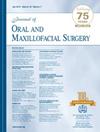舌截骨术能改善新生儿强直性咬合的母乳喂养吗?随机对照试验。
IF 2.6
3区 医学
Q2 DENTISTRY, ORAL SURGERY & MEDICINE
引用次数: 0
摘要
背景:强直性粘连的治疗及其对母乳喂养的影响仍然是一个有争议的问题,科学证据有限,特别是关于截骨术的应用。目的:研究舌截骨术对改善新生儿强直性咬合的母乳喂养效果和疼痛的影响。研究设计、环境和样本:我们于2015年4月至2017年10月在坦帕总医院进行了一项双盲随机对照试验。符合条件的母乳喂养困难和强直性咬合的母亲-新生儿对被随机分为截骨术或假手术。排除标准包括早产、大于2周、颅面异常、神经系统损伤或影响乳汁供应的母体疾病。预测变量:预测变量为舌系带管理,新生儿按1:1的比例随机分配为截骨术或假手术。结果变量:结果变量是LATCH评分(一种母乳喂养评估工具)和母亲疼痛评分(使用Wong-Baker疼痛量表)的变化,由一名盲法哺乳顾问在干预前后立即评估。协变量:协变量为新生儿年龄、胎龄、性别、种族、强直性咬合严重程度以及母体合并症。分析:进行描述性和多变量线性回归分析,显著性设置为P。结果:共纳入112对夫妇(55例[49%]截骨术,57例[1%]假手术)。两组间的LATCH和疼痛评分无显著差异(LATCH: 0.02;95% CI, 0.64 ~ 0.69;p = .9;疼痛:0.32;95% CI, 0.56 ~ 1.19;p = .5)。同样,多变量线性回归分析结果显示,两组在LATCH和疼痛评分的改善方面无显著差异(-0.11;95% CI, -0.89 ~ 0.68;P = .8和.38;95% CI, -1.20 ~ 1.96;P = .6)。结论:研究结果没有显示舌骨切开术和假手术在疼痛或LATCH评分的即时改善上有显著差异。因此,本研究不支持推荐舌截骨术来改善新生儿的母乳喂养困难。本文章由计算机程序翻译,如有差异,请以英文原文为准。
Does Lingual Frenotomy Improve Breastfeeding in Newborns With Ankyloglossia? A Randomized Controlled Trial
Background
The management of ankyloglossia and its impact on breastfeeding remains a controversial issue with limited scientific evidence, particularly regarding the utility of frenotomies.
Purpose
The study purpose was to determine the effects of lingual frenotomy on improving breastfeeding effectiveness and pain in newborns with ankyloglossia.
Study design, setting, and sample
We conducted a double-blind randomized controlled trial at Tampa General Hospital from April 2015 to October 2017. Eligible mother–newborn couplets with breastfeeding difficulties and ankyloglossia were randomized to frenotomy or sham procedure. Exclusion criteria included prematurity, older than 2 weeks, craniofacial anomalies, neurological compromise, or maternal conditions affecting milk supply.
Predictor variable
The predictor variable was lingual frenum management, and newborns were randomly assigned in a 1:1 allocation to frenotomy or sham procedure.
Outcome variables
The outcome variables were the changes in LATCH scores (a breastfeeding assessment tool) and maternal pain scores (using the Wong–Baker Pain Scale), assessed by a blinded lactation consultant before and immediately after the intervention.
Covariates
The covariates were newborn age, gestational age, sex, race, severity of ankyloglossia, as well as maternal comorbidities.
Analyses
Descriptive and multivariate linear regression analyses were conducted, with significance set at P < .05.
Results
A total of 112 couplets were enrolled (55 [49%] frenotomy, 57 [1%] sham). No significant differences were observed in LATCH or pain scores between groups (LATCH: 0.02; 95% CI, 0.64 to 0.69; P = .9; and pain: 0.32; 95% CI, 0.56 to 1.19; P = .5). Similarly, the results of the multivariate linear regression analyses showed no significant differences between the 2 groups for improvements in both LATCH and pain scores (−0.11; 95% CI, −0.89 to 0.68; P = .8 and .38; 95% CI, −1.20 to 1.96; P = .6, respectively).
Conclusions
The study findings did not demonstrate significant differences between lingual frenotomy and sham procedures on immediate improvements in pain or LATCH scores. Therefore, this study does not support the recommendation of a lingual frenotomy to improve breastfeeding difficulties in the immediate newborn setting.
求助全文
通过发布文献求助,成功后即可免费获取论文全文。
去求助
来源期刊

Journal of Oral and Maxillofacial Surgery
医学-牙科与口腔外科
CiteScore
4.00
自引率
5.30%
发文量
0
审稿时长
41 days
期刊介绍:
This monthly journal offers comprehensive coverage of new techniques, important developments and innovative ideas in oral and maxillofacial surgery. Practice-applicable articles help develop the methods used to handle dentoalveolar surgery, facial injuries and deformities, TMJ disorders, oral cancer, jaw reconstruction, anesthesia and analgesia. The journal also includes specifics on new instruments and diagnostic equipment and modern therapeutic drugs and devices. Journal of Oral and Maxillofacial Surgery is recommended for first or priority subscription by the Dental Section of the Medical Library Association.
 求助内容:
求助内容: 应助结果提醒方式:
应助结果提醒方式:


